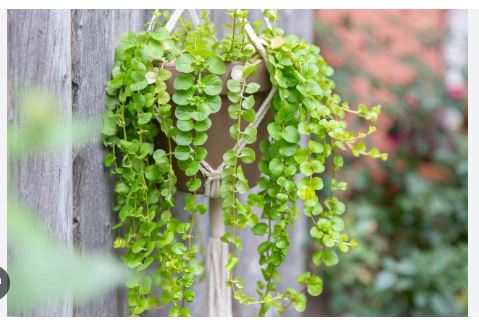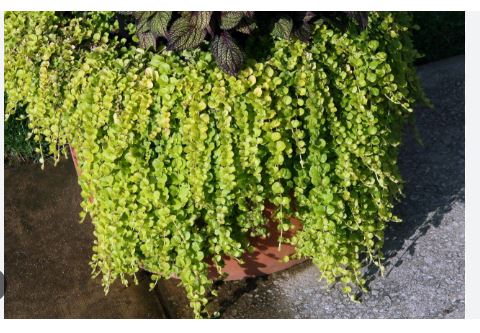
Creeping Jenny (Lysimachia nummularia and related species) is a versatile, low-growing perennial ground cover prized for its vibrant foliage and spreading habit. Part of the Primulaceae family, it offers a range of cultivars and related species with varied colors, textures, and growth patterns, making it ideal for borders, containers, rock gardens, or hanging baskets. While the species is native to Europe, its cultivars and close relatives are popular in USDA Zones 3–9 for their ornamental appeal.
The plant produces small, cup-shaped yellow flowers in late spring to early summer, complementing its bright green or golden leaves. It thrives in moist, well-drained soil and prefers partial shade, though some cultivars tolerate full sun. Its trailing stems root easily, enabling quick coverage but requiring control to prevent invasiveness.
Creeping Jenny adapts to a wide range of climates and is hardy in diverse zones. It excels in wet meadows, stream banks, or shaded borders, often cascading over walls or rocks. In some regions, it’s considered invasive, so gardeners should monitor its spread in natural areas.
Ideal for suppressing weeds or softening hardscapes, Creeping Jenny pairs well with taller perennials. Its low-maintenance nature suits novice gardeners, though regular trimming keeps it tidy. With proper care, it provides year-round texture and vibrant color, enhancing any garden setting.

Types of Creeping Jenny
Creeping Jenny ‘Aurea’
This popular cultivar of Lysimachia nummularia features bright golden-yellow foliage that intensifies in full sun. Growing 2–4 inches tall and spreading up to 2 feet, it produces small yellow flowers in early summer. Ideal for ground cover or cascading over walls, it thrives in moist, well-drained soil and partial shade to prevent leaf scorch in hot climates.
Creeping Jenny (Species Form)
The standard Lysimachia nummularia has lush green, coin-shaped leaves and bright yellow, cup-shaped flowers blooming from late spring to early summer. Reaching 2–4 inches tall with a 2-foot spread, it forms dense mats in moist, shaded areas. It’s perfect for wetland edges but can be invasive, so containment is key in small gardens.
Creeping Jenny ‘Goldilocks’
A vibrant cultivar, ‘Goldilocks’ boasts chartreuse to golden foliage, slightly darker than ‘Aurea’. Growing 2–3 inches tall and spreading rapidly, it blooms sparingly with yellow flowers. Its compact habit suits containers or rock gardens, thriving in partial shade and moist soil, with excellent cold hardiness in Zones 3–9.
Midnight Sun Creeping Jenny
This striking cultivar features deep bronze-green foliage with a glossy sheen, offering a darker contrast to traditional Creeping Jenny. Growing 2–4 inches tall, it spreads up to 18 inches and produces occasional yellow flowers. It’s ideal for edging or mixed planters, preferring partial shade and consistent moisture to maintain its rich color.
Lysimachia congestiflora ‘Eco Dark Satin’
A related species, this cultivar has dark green, slightly fuzzy leaves and clusters of bright yellow flowers in late spring. Growing 4–6 inches tall and spreading 12–18 inches, it’s less aggressive than L. nummularia. It thrives in full sun to partial shade, perfect for borders or as a filler in moist, well-drained soils.
Lysimachia punctata ‘Golden Alexander’
This upright relative of Creeping Jenny grows 12–24 inches tall with variegated golden-green leaves edged in cream. Its yellow flowers bloom in summer, adding vertical interest to borders. Spreading more slowly than L. nummularia, it prefers full sun and moist soil, making it a less invasive option for Zones 4–8.
Creeping Jenny ‘Persian Chocolate’
A cultivar of Lysimachia congestiflora, ‘Persian Chocolate’ features deep purple-bronze foliage and vivid yellow flowers in spring to early summer. Growing 4–6 inches tall with a 12–18-inch spread, it’s ideal for containers or as a dramatic ground cover. It thrives in partial shade and moist, well-drained soil.
Lysimachia ciliata ‘Firecracker’
This species offers upright growth (18–36 inches) with burgundy-purple foliage and small yellow flowers in summer. Its creeping rhizomes spread slowly, making it suitable for borders or naturalized areas. Hardy in Zones 3–8, it prefers full sun to partial shade and moist soil, adding bold color to mixed plantings.
Creeping Jenny ‘Gold Clusters’
This Lysimachia congestiflora cultivar has bright golden foliage and abundant yellow flower clusters from spring to summer. Growing 3–5 inches tall and spreading 12–18 inches, it’s perfect for hanging baskets or rock gardens. It thrives in full sun to partial shade and moist, well-drained soil, with good drought tolerance.
Lysimachia japonica ‘Minutissima’
A miniature species, this Japanese native forms dense, moss-like mats of tiny green leaves, growing just 1–2 inches tall and spreading 12 inches. Its small yellow flowers bloom in summer, ideal for rock gardens or between pavers. Hardy in Zones 4–8, it prefers partial shade and moist, well-drained soil.
Creeping Jenny ‘Beaujolais’
Another Lysimachia congestiflora cultivar, ‘Beaujolais’ features rich burgundy foliage with a metallic sheen and yellow flowers in spring. Growing 4–6 inches tall with a 12–18-inch spread, it’s striking in containers or as a ground cover. It thrives in partial shade and moist soil, offering a sophisticated contrast.
Lysimachia atropurpurea ‘Beaujolais’
This upright species (not a true creeping type) grows 18–24 inches tall with silvery-green leaves and spikes of deep purple flowers in summer. Spreading slowly via rhizomes, it’s suited for borders or damp areas. Hardy in Zones 4–8, it prefers full sun to partial shade and moist soil, adding elegance to gardens.
Lysimachia congestiflora ‘Outback Sunset’
This cultivar features golden-yellow foliage with green undertones and clusters of bright yellow flowers in late spring to early summer. Growing 4–6 inches tall and spreading 12–18 inches, it’s less aggressive than L. nummularia. Perfect for borders or containers, it thrives in full sun to partial shade and moist, well-drained soil.
Creeping Jenny ‘Gold Nuggets’
A compact Lysimachia nummularia cultivar, ‘Gold Nuggets’ boasts vivid chartreuse foliage that glows in full sun. Growing 2–3 inches tall with a 12–18-inch spread, it produces small yellow flowers in summer. Ideal for rock gardens or as a spiller in pots, it prefers moist soil and partial shade in hot climates.
Lysimachia procumbens ‘Golden Globe’
This low-growing species has glossy, golden-green leaves and star-shaped yellow flowers in spring to summer. Reaching 3–5 inches tall and spreading 12–15 inches, it forms tidy mats, perfect for edging or small spaces. Hardy in Zones 5–8, it thrives in partial shade and well-drained, moist soil.
Lysimachia congestiflora ‘Walkabout Sunset’
Known for its bronze-green foliage with golden highlights, this cultivar produces abundant yellow flowers in spring. Growing 4–6 inches tall and spreading 12–18 inches, it’s suited for ground cover or hanging baskets. It prefers full sun to partial shade and moist soil, offering a warm, glowing effect.
Lysimachia nummularia ‘Green Carpet’
This cultivar retains the species’ lush green foliage but forms a denser, more controlled mat, growing 2–4 inches tall and spreading up to 2 feet. Its yellow flowers bloom in early summer, ideal for shaded borders or stream banks. Hardy in Zones 3–9, it thrives in moist, well-drained soil.
Lysimachia clethroides ‘Geisha’
An upright relative, ‘Geisha’ grows 18–24 inches tall with creamy-yellow variegated leaves and white, arching flower spikes in summer. Spreading slowly via rhizomes, it’s perfect for borders or woodland gardens. Hardy in Zones 3–8, it prefers partial shade and moist soil, adding elegance to shaded areas.
Lysimachia congestiflora ‘Golden Anniversary’
This cultivar features bright golden foliage and prolific yellow flowers from spring to summer. Growing 3–5 inches tall with a 12–18-inch spread, it’s ideal for containers or rock gardens. Hardy in Zones 5–9, it thrives in full sun to partial shade and moist, well-drained soil, with good drought tolerance.
Lysimachia punctata ‘Alexander’
This upright species grows 18–24 inches tall with green leaves edged in creamy white, turning pinkish in cooler weather. Its yellow flowers bloom in summer, adding vertical interest to borders. Hardy in Zones 4–8, it prefers full sun and moist soil, spreading more slowly than L. nummularia.
Lysimachia congestiflora ‘Eco Moonlight’
Featuring pale yellow-green foliage with a silvery sheen, this cultivar produces clusters of yellow flowers in spring. Growing 4–6 inches tall and spreading 12–18 inches, it’s perfect for ground cover or mixed planters. It thrives in partial shade and moist soil, hardy in Zones 5–9.
Lysimachia japonica ‘Golden Star’
A compact Japanese species, ‘Golden Star’ forms dense mats of tiny, golden-yellow leaves, growing 1–2 inches tall and spreading 12 inches. Its small yellow flowers bloom in summer, ideal for rock gardens or between pavers. Hardy in Zones 4–8, it prefers partial shade and moist, well-drained soil.
Lysimachia congestiflora ‘Firefly’
This cultivar has dark green foliage with a bronze overlay and vibrant yellow flowers in spring to summer. Growing 4–6 inches tall and spreading 12–18 inches, it’s striking in containers or as a ground cover. It thrives in partial shade and moist soil, hardy in Zones 5–9.
Lysimachia nummularia ‘Emerald Mist’
A green-leaved cultivar with a softer, misty appearance, ‘Emerald Mist’ grows 2–4 inches tall and spreads up to 2 feet, producing yellow flowers in early summer. Ideal for shaded borders or wetland edges, it thrives in moist, well-drained soil and is hardy in Zones 3–9.
Why Choose Creeping Jenny Varieties?
These Lysimachia nummularia cultivars and related species, offer diverse foliage colors, from golden to burgundy, and varying growth habits for versatile landscaping. They’re low-maintenance, attract pollinators, and thrive in moist, well-drained soils, though some can be invasive in wetlands. Check local regulations, as L. nummularia is restricted in states like Connecticut due to invasiveness.
Tips for Growing Creeping Jenny
- Light: Provide full sun for golden cultivars, partial shade for green or dark varieties to prevent scorching.
- Soil: Use moist, well-drained soil; amend with compost for fertility.
- Watering: Keep soil consistently moist, especially in full sun; most tolerate brief dry spells.
- Care: Trim back in spring to control spread, divide every 2–3 years, and monitor for invasiveness in wet areas.